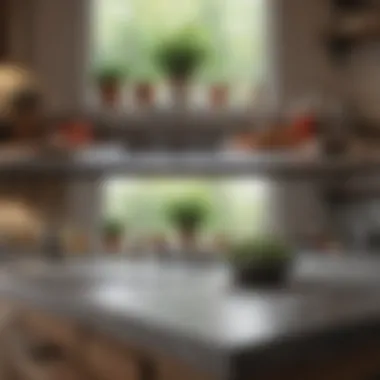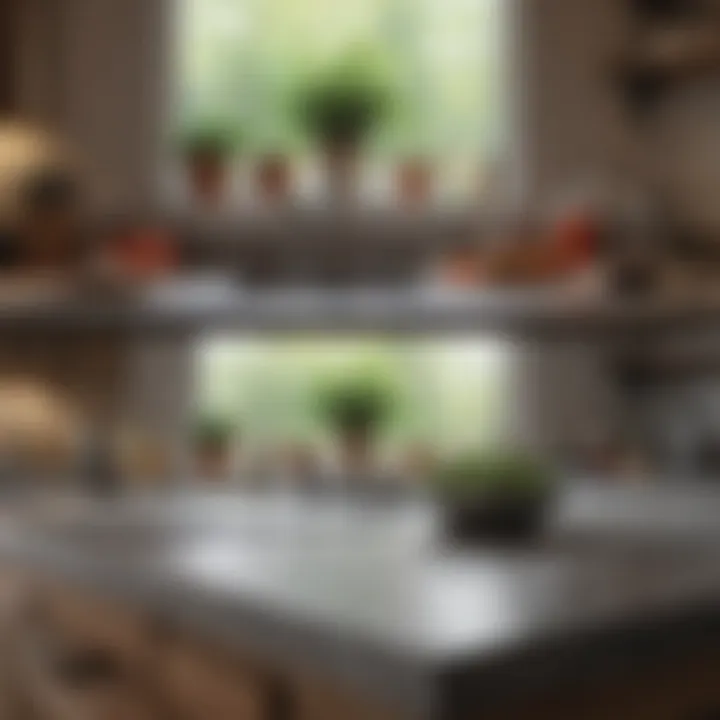Creating Organized Kitchen Counters: A Guide


Intro
Maintaining organized kitchen counters is more than a matter of aesthetics; it fundamentally enhances the functionality of a culinary space. An orderly kitchen can transform the cooking experience, allowing for greater efficiency and enjoyment. By examining the significance of an uncluttered countertop, one can appreciate the role it plays in both practical and psychological dimensions of kitchen design.
In this guide, we will explore various strategies and tools that can aid in achieving and maintaining organized kitchen counters. From understanding the impact of layout to selecting optimal storage solutions, readers will find practical advice tailored to various kitchen styles. We aim to provide insights into how an organized kitchen can not only increase productivity but also serve as an inviting environment for cooking and socializing.
Design Inspirations
Trending Styles
Kitchen design trends are ever-evolving, but certain styles consistently promote organization. Minimalist designs embrace simplicity, using clean lines and decluttered spaces. This style prioritizes functionality, often featuring hidden storage that keeps surfaces clear. On the other hand, industrial styles incorporate open shelving, providing both aesthetics and easy access to items while encouraging organisation through visual appeal.
To accommodate different needs, consider a blend of classic and contemporary elements. For instance, shaker cabinets paired with modern fixtures can create a timeless yet fresh look. Mix materials such as wood and metal to add texture, ensuring that the space remains visually engaging without sacrificing organization.
Color Palettes
Color can significantly affect the perception of clutter. Lighter tones, such as white or soft pastels, tend to make a space look larger and more open. A monochromatic palette can also create a cohesive look, contributing to an organized feel. Conversely, darker colors, when used thoughtfully, can lend an air of sophistication while emphasizing the organizational features within the kitchen.
Incorporating pops of color through accessories can energize the environment, while keeping the main surfaces neutral will help maintain an organized appearance. Consider using color-coordinated containers for storage, which not only facilitates organization but also enhances the overall aesthetic.
Maintenance and Upkeep
Seasonal Maintenance Checklist
Regular maintenance is essential to sustaining an organized kitchen counter. Here is a seasonal checklist to help keep your space in order:
- Spring: Deep clean all appliances; purge expired items.
- Summer: Organize utensils and tools for outdoor cooking; evaluate counter layout for efficiency.
- Fall: Reassess storage solutions; prepare for holiday entertaining.
- Winter: Clear clutter from holiday decorations; plan for any necessary repairs or updates.
By following this checklist, homeowners can ensure their kitchen remains a functional and inviting space throughout the year.
Cleaning and Organization Tips
- Declutter regularly: Make it a habit to remove items that no longer serve a purpose.
- Use trays and baskets: Group similar items together for easy access.
- Label containers: Clear labeling can help everyone in the household find what they need quickly.
These simple practices can lead to more sustainable organization habits, making upkeep less daunting.
"A well-organized kitchen allows for the joy of cooking to shine through, making meal preparation less of a chore and more of a pleasure."
In essence, creating an organized kitchen counter requires an understanding of design inspirations, maintenance practices, and the significant impact of a clutter-free environment. This guide serves as a foundation for homeowners and enthusiasts alike to achieve a functional and aesthetically pleasing kitchen. By implementing these strategies, one can transform their cooking space into an oasis of order and creativity.
Prelude to Kitchen Organization
In the realm of home management, kitchen organization holds a vital place. An organized kitchen is not just about aesthetics; it enhances functionality and promotes efficiency in daily tasks. When kitchen counters are tidy, it creates a welcoming atmosphere, making the space more pleasant to work in and reducing stress during food preparation. This article seeks to explore various factors involved in achieving an organized kitchen counter and how it contributes to a better living environment.
The Importance of an Organized Kitchen
The kitchen is often regarded as the heart of the home. It is where family gathers, meals are prepared, and memories are created. Thus, keeping it organized is paramount. An organized kitchen facilitates easy access to tools and ingredients, saving time and reducing frustration. When everything has its designated place, it encourages a smoother workflow in meal preparation and cooking. Furthermore, cleanliness can impact health. Preventing clutter minimizes the risk of grime accumulation, making for a safer cooking environment.
Moreover, an organized kitchen can enhance the overall ambiance of the home. A well-arranged countertop can act as a centerpiece, elevate the visual appeal, and communicate the homeowner's style. It reflects order and method, fostering a positive mindset, especially during stressful cooking endeavors.
Understanding Clutter and Its Effects
Clutter can have a profound effect not only on physical space but also on mental well-being. When counters are laden with items, it can become overwhelming. This environment can lead to decreased productivity as one's focus shifts from the task at hand to the chaos surrounding them. Studies suggest that a disorganized space can lead to increased stress levels and a sense of unease. By recognizing the adverse effects of clutter, homeowners can take proactive steps toward creating a more serene kitchen atmosphere.
Clutter might stem from several sources. Accumulation of rarely used gadgets, excessive decoration, and an overwhelming number of kitchen items can contribute. Understanding what constitutes clutter is the first step in counter organization. By identifying items that are essential and those that are extraneous, one can begin to reclaim counter space and enhance the functionality of their kitchen.
An organized kitchen counter embodies much more than mere storage; it cultivates a nurturing space for daily culinary endeavors and fosters a seamless experience while cooking.
Evaluating Your Kitchen Space


Evaluating your kitchen space is a crucial step in the journey toward an organized kitchen counter. It involves understanding how your kitchen is laid out and identifying the items you frequently use. By assessing these elements, you can create a functional layout that encourages efficiency and keeps clutter at bay. Proper evaluation serves not only to maximize your counter space but also enhances your overall cooking experience.
Assessing Layout and Accessibility
When considering the layout of your kitchen, accessibility becomes a key factor. An effective kitchen layout allows for a seamless flow during meal preparation. The placement of the stove, fridge, and sink should facilitate easy movement between these critical areas. Pay attention to how you work in the kitchen. Do you frequently find yourself reaching for tools or ingredients that are hard to get to? This could indicate the need for a reorganization.
- Check how much space you have between your items.
- Assess the ease of opening cabinets and drawers.
- Consider if your cooking style requires immediate access to certain tools.
For instance, if baking is a regular task, keeping measuring cups and mixing bowls easily accessible can save time and frustration. Conversely, rarely used appliances like a bread maker or juicer can be stored in less accessible areas. This careful consideration of layout not only creates a practical workspace but also contributes significantly to the visual harmony of the kitchen.
Identifying Frequently Used Items
Once the layout has been assessed, identifying frequently used items is next. Take stock of what you use in your daily cooking routines. This step is essential for curating a selection of tools and ingredients that deserve prime placement on your counter.
- Make a list of essential items: knives, cutting boards, spatulas, pots, and pans.
- Group similar items together. For instance, keep baking essentials like flour and sugar in close proximity.
- Observe your cooking patterns. If certain spices are used often, they should be front and center.
By focusing on these frequently utilized items, you ensure that your counter remains functional and clutter-free. This alignment of layout and item placement can drastically alter your kitchen experience, making cooking more enjoyable and less chaotic.
Tools for Kitchen Organization
In the quest for a well-ordered kitchen, the right tools can make a significant difference. Tools for kitchen organization not only help in managing space efficiently but also improve the overall cooking experience. Well-chosen tools facilitate easy access to your items, reducing the time spent searching for essentials while cooking. It is vital to select tools that align with your kitchen's specific needs, thus offering practical benefits to your daily routine.
Choosing the Right Storage Solutions
Selecting appropriate storage solutions is key in creating organized kitchen counters. Consider the available space in your kitchen before diving into purchases. Bins, baskets, and drawer organizers can help group similar items. For instance, using a clear container for frequently used spices keeps them visible and accessible. Additionally, pull-out drawers can transform otherwise unused spaces in lower cabinets into functional areas.
When evaluating storage solutions, prioritize modular options. Products like the mDesign Kitchen Storage Bins or OXO Good Grips Food Storage Containers allow personalization and adaptability. They fit various items and can be reconfigured to suit changing needs. Incorporating these choices means flexibility for future adjustments and maintenance.
Utilizing Vertical Space
Vertical space often goes unnoticed in kitchen planning but is essential for maximizing efficiency. Shelving units and wall-mounted racks provide opportunities to enhance storage without adding clutter to counters. For instance, installing open shelves above counters enables you to display decorative items while keeping necessary tools at arm's reach.
Additionally, utilizing hanging solutions for pots and pans alleviates cabinet congestion. Equip your kitchen with pot racks to free up valuable drawer and shelf space. By focusing on vertical organization, you create a cleaner surface for preparation work, fostering a more enjoyable cooking environment.
Innovative Countertop Accessories
Innovative countertop accessories contribute to both functionality and aesthetics. Items like the Cuisinart 77-17N 17-Piece Set ensure that not only are your tools organized, but they also complement your kitchen's design.
Consider investing in multi-functional accessories. For example, a kitchen cart can serve as extra workspace. When not in use, it can be pushed aside. Another accessory to contemplate is a magnetic knife strip. This clears countertop space and enhances safety by keeping sharp objects out of reach of children.
In Summary
Finding the right tools for kitchen organization can be transformative. You can significantly improve the functionality and aesthetic appeal of your space. In this process, choosing the right storage solutions, utilizing vertical space, and incorporating innovative accessories are essential steps to attaining an organized cooking environment.
"An organized kitchen can lead to a more enjoyable cooking experience, simplifying meal preparation and enhancing creativity in the kitchen."
When thoughtful organization becomes a priority, you set the stage for culinary success in your home.
Establishing a Personal Organization System
Establishing a personal organization system in your kitchen is essential for achieving a space that is both functional and inviting. An effective system allows you to tailor your kitchen organization to your specific needs, preferences, and habits. This makes it easier to locate frequently used items swiftly, reducing time spent searching and creating a smooth cooking experience. Furthermore, a well-defined system contributes to maintaining an aesthetically pleasing environment, which can enhance the overall quality of your daily culinary tasks.
When creating your organization system, consider aspects such as how you use your kitchen, the available space, and the types of items you regularly interact with. This thoughtful planning can have significant benefits, including increased efficiency, reduced clutter, and a more enjoyable cooking atmosphere. An organized kitchen leads to a better workflow, allowing you to focus on meal preparation rather than wasted time.
Categorizing Kitchen Items
The first step in establishing an effective organization system is to categorize your kitchen items. Start by assessing all your kitchen tools, utensils, and other items. Group them into categories based on their function or usage frequency. For example, you can have sections dedicated to:
- Cooking utensils (spoons, spatulas, whisks)
- Baking tools (mixing bowls, measuring cups, rolling pins)
- Small appliances (toaster, blender, coffee maker)
- Food storage (containers, plastic wrap, aluminum foil)


Once categorized, determine a dedicated space for each group on your countertops. Place frequently used items within reach and store less-used tools out of sight. This method not only brings order, but also helps you understand what you may have duplicates of or no longer need.
Implementing a Functional Workflow
After categorizing your kitchen items, the next step is implementing a functional workflow. A well-planned workflow enhances kitchen efficiency, which is vital in today’s fast-paced lifestyle. Consider the following points while designing your workflow:
- Preparation Station: Establish an area for food preparation that is free of clutter. Keep only essential tools handy, such as knives, cutting boards, and mixing bowls.
- Cooking Zone: Position cooking appliances like the stove and oven near your prep area. This minimizes movement and creates a smooth transition from preparation to cooking.
- Serving Area: Allow space near your kitchen entrance or dining area for plating dishes. This makes it easy to transfer food from the cooking zone to the table.
- Cleaning Up: Designate an area for dirty dishes and implements that aid in a quick clean-up process. Include essential tools such as dish soap, sponges, and towels nearby.
Implementing these strategic zones will streamline your kitchen workflow and reduce unnecessary movement. Think about how your cooking habits dictate your space usage.
A personalized kitchen organization system can change how you cook, making the process efficient and more enjoyable.
Overall, establishing a personal organization system is not merely about aesthetics. It is an important step in transforming your kitchen into a practical space that aligns with your lifestyle and enhances your cooking experience.
Practical Tips for Maintaining an Organized Counter
Maintaining an organized kitchen counter is vital for efficiency and aesthetics. It ensures a pleasant cooking environment, improves accessibility to frequently used items, and reduces stress during meal preparation. An organized counter breeds a sense of calm and control in a space often prone to chaos. Implementing practical tips can transform your kitchen experience immensely.
Cleaning and Decluttering Regularly
Cleaning and decluttering should be a consistent habit for any homeowner. A clean counter looks inviting and adds to overall kitchen hygiene. Start by setting aside a few minutes daily to clear away kitchen items that do not belong on the counter. Use this time to wipe down surfaces with a suitable cleaner, ensuring a fresh appearance.
When you declutter, ask yourself these questions:
- Is this item used regularly?
- Does this align with my kitchen's function?
- Could it be stored elsewhere to save space?
Assessment leads to a more functional kitchen setup. In a clutter-free space, you can find tools and ingredients quickly, allowing for a smoother cooking experience.
Regular cleaning and decluttering not only enhances the aesthetic appeal but also contributes to the longevity of kitchen items by protecting them from unnecessary wear.
Creating a Maintenance Routine
Establishing a maintenance routine is crucial for sustaining organization. Start by scheduling specific times for cleaning tasks on a weekly basis. For example, you might focus on deep cleaning the counter and organizing storage once every weekend.
There are several practical steps to consider when creating this routine:
- Weekly Overview: Take stock of the items on your counter. Remove anything that does not belong.
- Designate Zones: Assign specific areas for different tasks like prep work, cooking, or serving. Keeping similar items in close proximity saves time.
- Monthly Inventory: Once a month, evaluate your supplies. Check expiration dates of ingredients and dispose of anything no longer usable.
- Seasonal Reset: Change items according to seasons or holidays, ensuring your decor matches your current cooking needs.
By following a structured maintenance routine, you can foster habits that support long-term organization. Remember that organization is not a one-time act but rather an ongoing journey. A well-maintained kitchen counter not only enhances functionality but also encourages mindfulness and creativity in cooking.
Style Considerations in Kitchen Organization
When it comes to organizing kitchen counters, style considerations play a crucial role. This aspect not only influences the overall appearance of the kitchen but also impacts functionality and user satisfaction. A well-organized kitchen counter can complement the design of your home, reflecting personal taste while maximizing efficiency. Homeowners need to understand how integration of these elements can result in a harmonious and practical workspace.
Integrating Aesthetics with Functionality
The balance between aesthetics and functionality is vital in any kitchen organization strategy. An organized countertop should not only look appealing but also serve its purpose effectively. To achieve this, consider the following:
- Select Multi-Functional Tools: Choose items that serve more than one purpose. For example, a stylish fruit bowl can also act as a decorative piece.
- Minimize Visual Clutter: While it's important to have decorative elements, too many can be overwhelming. Aim for a clean look that doesn’t sacrifice usability.
- Use Cohesive Themes: Stick to a certain style—like rustic, modern, or coastal. This unity can create a visually appealing counter that is also easy to navigate.
Ultimately, creating a visually pleasant area that functions well leads to a positive cooking experience.
Choosing Colors and Materials
Color choice and materials have a significant effect on the organization and overall feel of kitchen counters. Here are some important factors to consider:
- Color Coordination: Choose colors that match or complement your kitchen’s overall color scheme. Light colors can make a small kitchen feel larger, while darker tones can provide warmth and coziness.
- Material Durability: Select materials that can withstand daily use. Natural stone or high-quality composites are not only stylish but also highly functional. They resist stains and scratches, which makes them practical for busy kitchens.
- Texture Elements: Incorporating different textures such as wood, metal, or ceramics can add depth. This should be done sparingly to avoid overwhelming the counter space.
In summary, thoughtful consideration of style elements greatly influences the overall experience in the kitchen. An organized kitchen counter can boost both efficiency and visual appeal, making cooking and hosting gatherings more enjoyable.


Addressing Unique Kitchen Challenges
Addressing unique kitchen challenges is essential for creating an organized and functional kitchen. Every kitchen comes with its own set of obstacles, whether due to limited space, shared usage with family or roommates, or specific design styles. Understanding these challenges can lead to tailored solutions that enhance the overall cooking experience.
Solutions for Small Kitchens
Small kitchens pose a significant challenge for effective organization. Limited counter space forces homeowners to utilize every square inch wisely. Here are several strategies to organize small kitchens:
- Use Multi-Functional Furniture: Equip your kitchen with items that serve multiple purposes. For example, consider a kitchen island with storage underneath. It can act as both a prep area and a storage space.
- Maximize Vertical Space: Install shelves above counters or cabinets. This method utilizes walls for storing items, freeing up space on counters. Hanging racks or pegboards can hold utensils and pots, making them easily accessible.
- Minimize Clutter: Be selective about the items kept on counters. Limit appliances and tools to the most frequently used items. Store others away to create an open and tidy space.
- Rotate Seasonal Items: Storing seasonal items out of sight allows you to keep only the essentials on hand. This practice can prevent overcrowding and helps keep items relevant.
Adopting these solutions can transform a small kitchen into an organized and functional space that meets daily needs without feeling cramped.
Organizing Shared Spaces
When a kitchen is shared among multiple users, organization becomes crucial. Different habits can lead to clutter and chaos. To maintain harmony in shared kitchen spaces, consider the following:
- Designate Zones: Clearly define areas for specific tasks. A cooking zone, cleaning zone, and prepping zone can streamline movements and reduce overlap. Each user understands where their items belong, minimizing confusion.
- Establish Shared Rules: Establishing guidelines for cleanliness and organization can help harmonize the shared space. Users should agree on responsibilities. For example, deciding who cleans up after meals prevents disputes.
- Use Clear Containers: Utilizing transparent storage can help all users identify where items are stored. This can reduce searching and help maintain order among various contributors to the space.
- Regularly Evaluate: Establish a routine to reassess organization practices. Monthly check-ins can help to adapt the system as needed, especially if preferences or habits change over time.
Taking these measures can create a more inviting and functional shared kitchen environment where every user feels respected and organized.
The Psychological Benefits of an Organized Kitchen
An organized kitchen does more than enhance aesthetic appeal; it profoundly influences the mental state of those who cook in it. The psychological impact of a well-structured kitchen cannot be understated. When the counters are clear and thoughtfully arranged, it promotes a sense of control and order. This environment can lead to increased productivity and creativity in meal preparation.
An organized kitchen also alleviates cognitive overload. Clutter can distract and overwhelm, making it challenging to focus on the task at hand. This section will explore two vital psychological benefits: enhancing mindfulness and focus, and creating a stress-free cooking environment.
Enhancing Mindfulness and Focus
Mindfulness in cooking can be significantly enhanced by an organized kitchen. When everything is in its place, individuals can become more attentive to the process. They can enjoy the act of cooking without the burden of disorder surrounding them.
Having a clear and systematic setup allows for better engagement with ingredients, techniques, and the overall culinary experience. Moreover, it channels attention to the flavors and aromas that arise while cooking, nurturing a deeper connection to the food being prepared.
A clutter-free space encourages individuals to be present. This can mean appreciating the textures of vegetables, measuring ingredients mindfully, or observing the transformations that occur during cooking. As a result, this leads to a more fulfilling cooking process, reducing the usual distractions of modern life.
Creating a Stress-Free Cooking Environment
The emotional benefits of an organized kitchen environment are profound. Stress often accompanies chaos. When counters are cluttered with gadgets and miscellaneous items, it can lead to frustration and an aversion to cooking. In contrast, an organized kitchen fosters a sense of calm.
Key factors to consider include:
- Visual Cleanliness: A tidy counter inhibits anxiety. Seeing a clear workspace can trigger positive feelings and the motivation to cook.
- Accessibility: When items are easy to reach and appropriately stored, it minimizes frustration. This setup not only saves time but also prevents the feeling of being overwhelmed.
- Routine: An organized kitchen often supports a structured cooking routine. Knowing where everything is gives a sense of reliability.
"An organized kitchen sets a tone of tranquility, making cooking a more enjoyable and less stressful task."
In summary, the psychological benefits of an organized kitchen are valuable. By enhancing mindfulness and creating a stress-free atmosphere, individuals can significantly improve their cooking experiences and overall home environment. Regularly maintaining order in the kitchen can lead to lasting positive changes in mindset and well-being.
Epilogue
An organized kitchen is more than just about aesthetics; it fundamentally influences productivity and peace in the cooking space. The conclusion of this article serves as a reminder of several key elements discussed that encompass the value of maintaining organized kitchen counters. With the strategies outlined, homeowners can transform their kitchen experiences, ensuring ease of access to tools and ingredients while fostering a more enjoyable cooking atmosphere.
In this guide, we emphasized the importance of evaluating your space, identifying what items are essential, and utilizing appropriate storage solutions that suit individual needs. Each step taken towards organization opens doors to a more functional kitchen. Moreover, the psychological benefits cannot be overlooked; a tidy workspace encourages mindfulness and creativity in food preparation. An organized counter leads to a decluttered mind, making the cooking process not only efficient but also therapeutic.
"Every small step towards order creates a ripple of positive changes in daily life."
In summary, this article highlights the strategies that contribute to a well-maintained kitchen counter and its broad-reaching effects on lifestyle, productivity, and overall mental wellness.
Recap of Key Points
- Understand the Importance of Organization: An organized kitchen fosters efficiency and enhances creativity.
- Assess Your Specific Needs: Know what items you use most often to determine how best to store them.
- Choose the Right Tools: Select storage solutions that not only fit your space but also reflect your cooking style.
- Maintain Regularly: Make cleaning and organizing a habit to prevent clutter from building up.
- Keep Aesthetic in Mind: Consider how the design elements of your kitchen impact its functionality.
Encouragement for Ongoing Organization
Making organization a continuous journey can yield profound benefits. Establish a regular maintenance routine that allows for easy updates to your organization system. Re-evaluate your counters and storage every few months, ensuring that what occupies your space serves a purpose. Additionally, involve all family members in this process to share responsibility and foster a collective understanding of organization.
Remember, the aim is not perfection but a cohesive space that enhances your cooking experience. As you continue to adapt and refine your kitchen organization practices, you will find it becomes easier to maintain an inviting and functional environment. Embrace this journey, knowing that each effort adds up to create a kitchen where cooking is a pleasure, rather than a chore.







